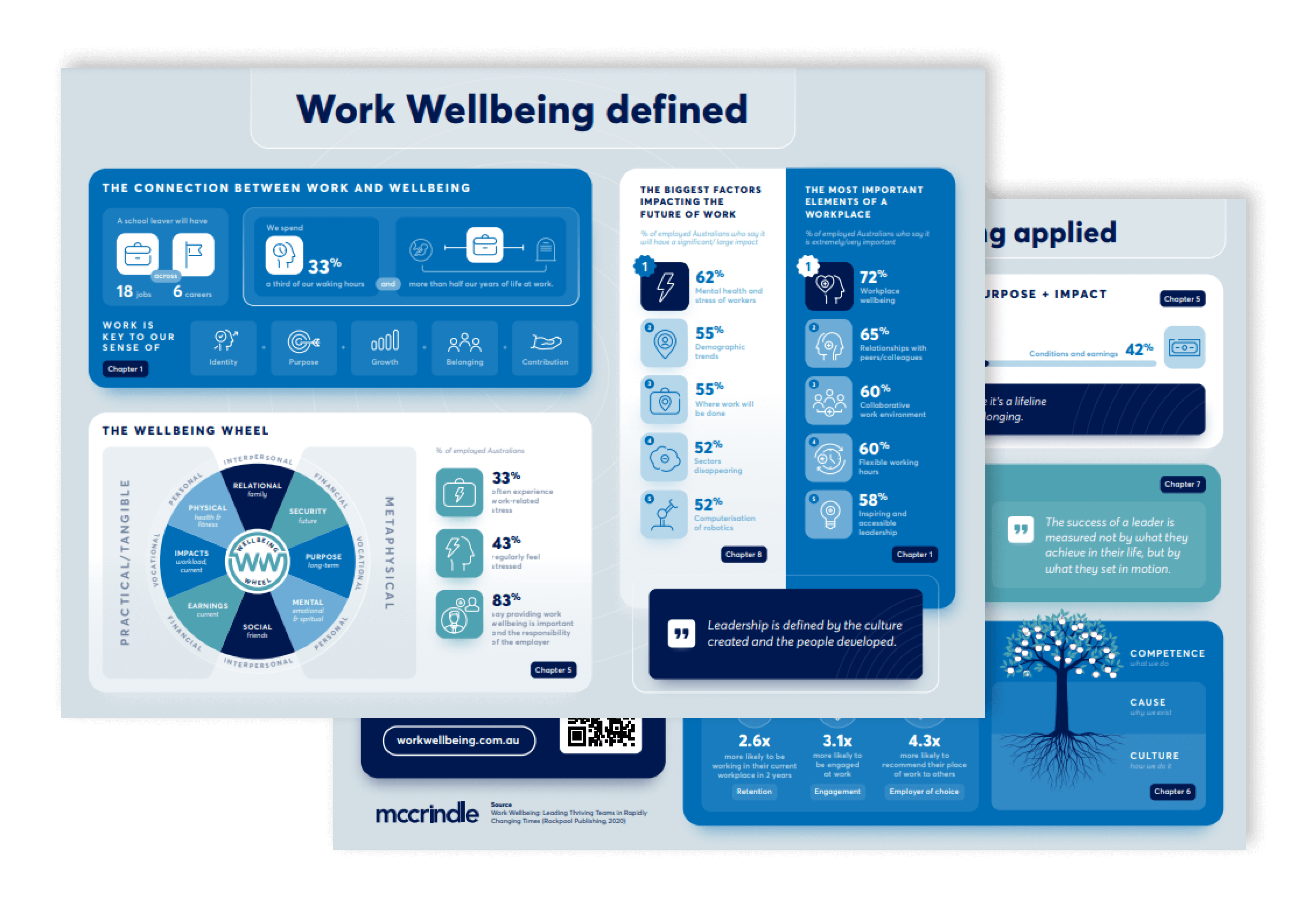Work Wellbeing
How schools can prioritise work wellbeing in the current and post COVID-19 era

Work. It’s a big part of one’s life and always has been. But over the last few years the always-on technologies and office-in-our-pocket has made it harder than ever to switch off and distinguish the difference between work and rest. This blurring of work and life was further entrenched during COVID-19 where the biggest transformation to how, where and when we work and learn took place.
Like many others, the education sector had to respond with swift adaptability and resilience to a changing world. And the Australian public are grateful for the way that it did. According to our national research of 1,004 Australians, 71% of those who participated in online education said it was a positive experience for their household. This was largely due to the support provided by schools and the opportunity to spend more time with their child. The greater engagement in their child’s learning also allowed families and parents to develop a greater understanding of their child’s skills, abilities and challenges with learning. For this, the education sector should be commended.
But of course, it was not without its toll on the leaders, teachers, and school staff. Although the education sector is to be commended for the way it responded to the rapid changes, the impact of what it took to respond on people’s social, financial, physical and mental wellbeing should not be understated or overlooked.
As we begin to consider what work wellbeing will look like in the current and post COVID-19 era, here are some ways to build healthy work-life integration for the education sector.
Build a culture of prioritising wellbeing
There are many reasons why work wellbeing (the attitude of valuing employees embedded into the culture of an organisation) needs to be at the top of the agenda of workplace leaders. The education sector, perhaps more than most others, faces significant health concerns from people being overworked and stressed, which not only impacts people’s personal health and ability to thrive, it also leads to increased turnover, impaired productivity and engagement with the role. All of these issues will affect a school’s ability to perform well.
In our national survey of 1,160 workers, more than one in five (22%) said the main reason they left their previous employment situation was because of the work-life balance (or the lack thereof). For many teachers, work and life, or work and rest, have become more blurred than ever.
The term ‘work-life balance’ is a concept used to distinguish between work responsibilities and other aspects of our personal wellbeing such as the social, relational, spiritual or financial. But as work continues to permeate other areas of our life, a new term is replacing that of the work-life balance equation. And that’s work-life integration. This term helps us to see that work and life are ideally not in competition, but that our ‘at work’ life and our ‘away from work’ life are both key to our contributions, relationships and fulfilment.
While COVID-19 posed many challenges, it also provided a unique opportunity to recalibrate a focus on wellbeing. Schools who can take this focus on wellbeing and build it into the culture will make a positive impact on themselves and their staff. This might translate to encouraging people to take regular breaks from work, finish on time, draw healthy boundaries or prioritise aspects that make their work enjoyable and sustainable.
Regularly remind yourself (and your team) of the organisation’s purpose
Rather than viewing work as a separate part of life, or simply an obstacle to overcome, work is an important and significant part of our life. After all, people work for more than just remuneration. According to our national survey of 1,001 workers, 63% said work is extremely/very important to a having a sense of purpose. Workers also said work is extremely or very important to developing them as a person (59%), making a difference in the lives of others (58%), bettering society and the world (55%) and contributing to a sense of community and belonging (54%).
Today people see less differentiating between work-life and out-of-work-life, or one’s job and one’s personal values. In response, leaders who can regularly communicate the organisation’s purpose to themselves and others will likely be more motivated and inspired to do their best work.
Invest in the school community
While there are many benefits to remote working such as the resulting time savings (no commute), cost savings (on travel and lunches out), and better work-life integration, our national research during the pandemic showed that there are also challenges such as the blurring of boundaries, social isolation and less opportunities for collaboration.
Even though online learning was a blessing for many during COVID-19 and 52% of Australians believe education will be delivered more online in the future, the sentiment of many students and teachers is that they looked forward to going back to school. While Zoom helped connect people during the pandemic, many suffered from ‘zoom fatigue’ and missed interacting with friends and colleagues in person. This highlights that workplaces and places of education are more than just somewhere we go to learn – they are key pathways to social interaction, connection and belonging.
Those that invest in their school community make it a more enjoyable place and experience for other leaders, teachers, parents and students. Those who regularly communicate with others and those they are leading, are intentional about checking in with colleagues and co-workers and look for opportunities to collaborate in new ways will help people and the organisation to thrive in the new normal.
Remember that work wellbeing is key to the future of work
In our survey of Australian workers, we asked about what trends will most impact the future of work. Of the seven factors we tested, ‘mental health and stress of workers’ was the one most workers believed would have the most significant impact (62%). This was above demographic trends, the physical workspace and where work will be done, sectors disappearing, computerisation of robotics, global workforce trends and the gig economy.
So if you’re an educator feeling exhausted from a big year – know that that’s ok and take the necessary time to invest in your own wellbeing. This could simply take the form of getting better (or more!) sleep, speaking with someone about the challenges you are facing, investing into your physical or spiritual health or taking a much-needed break from work. It’s ok to prioritise your personal wellbeing – it’s not only key to your own future but for the wellbeing of those around you. Bringing our best self to work is one of the greatest gifts we can give to ourselves and our colleagues, students and our community.
The world of work is changing – from demographic shifts to technological advancements and a global pandemic. COVID-19 has simply increased the recognition that the health, social connection and purpose – wellbeing – is an essential factor that will impact and define the future of work, and the future of schools. Workplaces need to adapt and respond, so that workers are looked after while also being stretched and grown in capacity, and all in an environment in which they can flourish and thrive.








